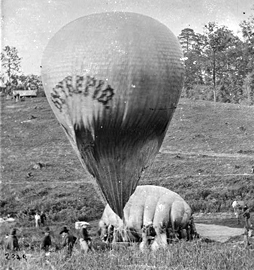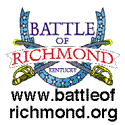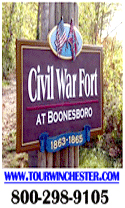|
Civil War’s first air force confrontation
featured Intrepid, Washington, Gazelle
At Mechanicsville, Va., it’s know as the Civil War’s “Kitty Hawk Moment.”
It was there, on June 27, 1862, that balloons manned by Confederate and Union aeronauts floated above a field of battle - the first time warring armies sent their air ships aloft simultaneously over U.S. soil.
On that date, two Union balloons - the Intrepid and the Washington - rose aloft only miles west of Richmond while their Southern counterpart, Gazelle, floated over the capital of the Confederacy. The balloons were the unarmed drones of war, collecting intelligence on rival troop movements from a vantage of 1,000 feet above the earth.
This was the first time that opposing American air forces were facing each other.
The Civil War Trust is seeking to save the ground where the Union launched its balloons. Little of the original battlefield has been preserved, but the 285-acre slice of the Gaines' Mill battlefield includes a ravine that shielded the North's balloons from Confederate troops while they were launched.
Gaines' Mill was the stage for the one of the biggest and bloodiest battles of the Civil War and the battleground where Confederate Gen. Robert E. Lee recorded his first victory. The June 27, 1862, battle repulsed Union forces and their Peninsula Campaign, a disastrous attempt starting in March 1862 to occupy Richmond by way of the peninsula between the York and James rivers. The battle involved nearly 100,000 troops and left more than 15,000 dead or wounded.
Until the Civil War, balloons were fairgrounds attractions, taking the curious aloft for a few dollars.
New Englander Thaddeus S.C. Lowe, changed all that. The father of military aerial reconnaissance had planned a trans-Atlantic balloon crossing until he was appointed by President Abraham Lincoln as chief aeronaut of the Union's balloon corps. He dazzled the president by taking a balloon over the White House and telegraphing a message to Lincoln in June 1861. That was the beginning of the Union's earliest "air force" and balloons would later be sent aloft on several occasions to spy on enemy lines - but not at the same time by rival forces until Gaines' Mill.
Today, the Union balloon camp is found beyond a field of grazing beef cattle and in a ravine studded with decaying logs and a thicket of boot-snagging grasses. In this trough, Union aeronauts hauled in wagons to inflate the balloons.
The Gazelle, which was stitched together using silk common to dressmaking, was launched from a rail track close to Richmond.
While Confederate forces had balloons, the North had the technological and financial edge to assemble a balloon corps. However, even the Union's use of balloons was limited to a couple of years. Military leaders weren't quite sure how to effectively deploy this novelty.
The balloons were tethered as aeronauts relayed observations by telegraph, the communication wire dangling to the ground. Residents in Richmond could see the Union inflatables.
The Union balloons were made of thick silk with a coat of varnish enveloped by a netting of Italian flax thread. The basket was made of willow and cane and had an armored floor.
The Civil War wasn't the first time balloons were used in a wartime environment. More than a half century before, France created the Corp d'Aerostiers in 1794. They too were used for military reconnaissance.
Lowe, described as a showman, designed balloons that were sturdier than the fairground versions with some able to carry five people aloft. One of the largest, the Intrepid, had a portrait on the balloon depicting Maj. Gen. George B. McClellan, who led the Union's Peninsula campaign. The portrait was suspended from an eagle's beak.
The Union's balloon corps, which included seven inflatables, was sent aloft during the Peninsula campaign at Yorktown and at the Union-held Fortress Monroe in Hampton, Va. There was even an early forerunner of an aircraft carrier: two balloons and their gas generators were loaded onto a converted coal barge for observations over water.
Despite the Union's dominance of the skies, Lee's troops had a rare edge in numbers at Gaines' Mill and the Southern forces were able to drive back the Army of the Potomac and save the Confederate capital.
|













